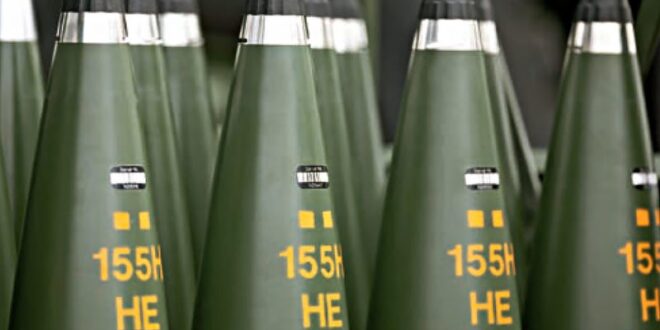As Western production fails to meet targets, most ammunition Ukraine uses for its counteroffensive are from South Korean stocks, Euromaidan Press’ defense sources say
The European Union has privately informed member states that the bloc is very unlikely to fulfill its pledge to provide Ukraine with 1 million rounds of artillery ammunition by the March 2024 deadline, Bloomberg reported. EU diplomats were briefed this week that the ambitious ammunition target would probably be missed, based on information from people familiar with the matter.
Under plans made on 20 March 2023, the EU had committed to supplying the 1 million artillery rounds to Ukraine over a 12-month period. The bloc aimed to meet this goal first by tapping existing ammunition stockpiles and then through joint procurement contracts to ramp up industrial capacity.
However, more than halfway through the allotted timeframe, the initiative has so far only delivered around 30% of the target, Bloomberg reported on 26 October 2023.
Some member states have been reluctant to disclose full details of their own ammunition supplies to Ukraine. The issue is expected to be discussed at a meeting of EU defense ministers next week, where the bloc may push for greater transparency from capitals on planned deliveries in order to get a complete picture of the shortfall.
Providing ammunition to Ukraine has become more urgent as Russia increases its own production, possibly aided by supplies from North Korea, some member states noted, as per Bloomberg. As Ukraine braces for a prolonged war, any shortfall from the EU risks becoming critical if US assistance also slows.
The Pentagon said this week it had started to throttle back military aid to Ukraine due to funding delays in Congress.
EU ammunition production plan unrealistic
The shortfall was predictable, according to the Ukrainian outlet Defense Express: the EU did not set either a realistic timeframe, nor did it dedicate enough funds.
Given that the EU delivered 300,000 rounds to Ukraine between March and October 2023, its average tempo of delivery was 42,800 rounds a month (1,426 per day). This includes both stocks and production.
At the same time, the USA, Ukraine’s main source of artillery ammunition, was producing 28,000 rounds per month in October 2023, doubling what it was producing at the start of the year and surpassing plans of 24,000 by the end of 2023.
This number is set to increase: the US plans to be producing 100,000 rounds a month in 2025. This means that the US, with all its artillery ammunition production capacities, will need at least two years to hit the 1 million shells production benchmark. For this increased production, and to replace the stocks of ammunition sent to Israel and Ukraine, the Pentagon has requested a $3.1 bn drawdown, in addition to requested $106 bn funding.
Meanwhile, the EU allocated only €0.5 bn for boosting artillery production in May, in addition to the €1 bn allocated for procuring ammunition from member states.
Therefore, with less funds and a shorter timeframe than the US, the EU’s original plan to deliver 1 million rounds to Ukraine in a year was set to fail. This shortcoming was evident from the start: in February, Estonia stressed that the EU should invest €4 bn into ammunition production to meet the target of 1 million shells a month.
Ukraine’s needs: 590,000 shells a month
How much is 1 million rounds a year, or 2,800 a day? As of March 2023, then Defense Minister Reznikov admitted that Ukraine is using 110,000 155-mm artillery shells per month, i.e. 3,600 a day, in a letter requesting 250,000 rounds a month from the EU.
According to him, on average, Ukraine fired 110,000 155-mm caliber shells per month, a quarter of the amount used by Russia. According to the Ministry of Defense, Ukraine’s minimum requirement for successful combat missions is more than 350,000 shells.
If Ukraine were to use all the capabilities of the artillery systems it has, Reznikov said, the military could spend more than 590,000 shells a month.
In May, Reznikov said that Russia fires 25,000-30,000 shells of various calibers a day, which is 7-8 times more than Ukraine’s 3,600 a day.
Meanwhile, according to Ukraine’s military intelligence, Russia plans to ramp up its production to 2.1 million shells in 2024. This cannot be done without the help of third countries, intelligence said, hinting at the ways that Russia circumvents western sanctions.
Faced with the slow production rate growth in the West amid its depleted material base, most of the shells Ukraine used for its 2023 counteroffensive have come from South Korea, with its massive missile stocks created with the possibility of a massive war with North Korea in mind, a defense source familiar with the matter told Euromaidan Press.
Given that North Korea is now delivering artillery shells to Russia, which were also produced with the war against its southern neighbor in mind, we are seeing the demilitarization of the Korean peninsula in Ukraine, the source said. Recently, South Korean intelligence claimed that North Korea had delivered 1 million artillery shells to Russia, enough for “two months of shelling.”
Deficit of artillery
In February, Bloomberg wrote that Russia’s war against Ukraine has depleted NATO allies’ stockpiles and revealed production gaps.
Now, NATO countries are seeking to increase production capacity and have agreed to change their ammunition stockpiling guidelines to better plan for a potential future conflict.
As of February 2022, Russia fired the same amount of ammunition in one day of war as Europe can produce in a month.
Currently, Russia’s ammunition production capacities are seven times higher than the West’s and exceed its pre-war production, according to Kusti Salm, Permanent Secretary of the Estonian Ministry of Defense, the NYT reported in September. He cited Russia’s cheaper production costs as part of the reason: it costs a Western country $5,000 to $6,000 to make a 155-millimeter artillery round, whereas it costs Russia about $600 to produce a comparable 152-millimeter artillery shell, he said.
Ukraine has been increasing its own production capacity as well. In January, Ukraine’s state-owned Ukroboronprom, together with a NATO member state, begun producing 125-mm shells for tank guns. In the same month, the first 122-mm artillery shells made in Ukraine were delivered to the Ukrainian Armed Forces.
According to Ukrainian officials, artillery shells produced in Ukraine are three times cheaper than western analogues. The concrete production numbers are unclear, but strategic industries minister Kamyshin said in August 2023 that Ukraine increased its ammunition production tenfold compared to 2022.
 Eurasia Press & News
Eurasia Press & News




